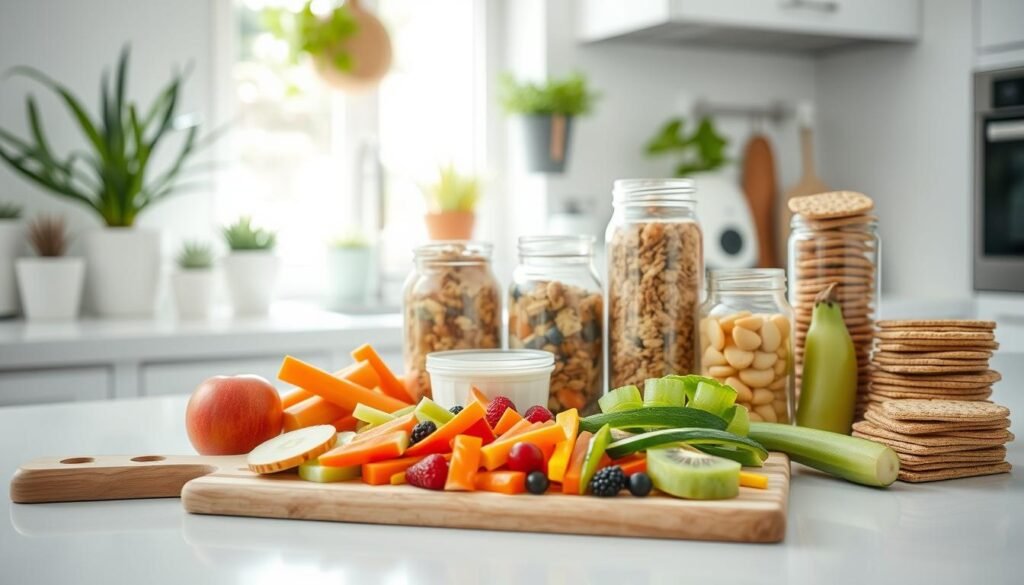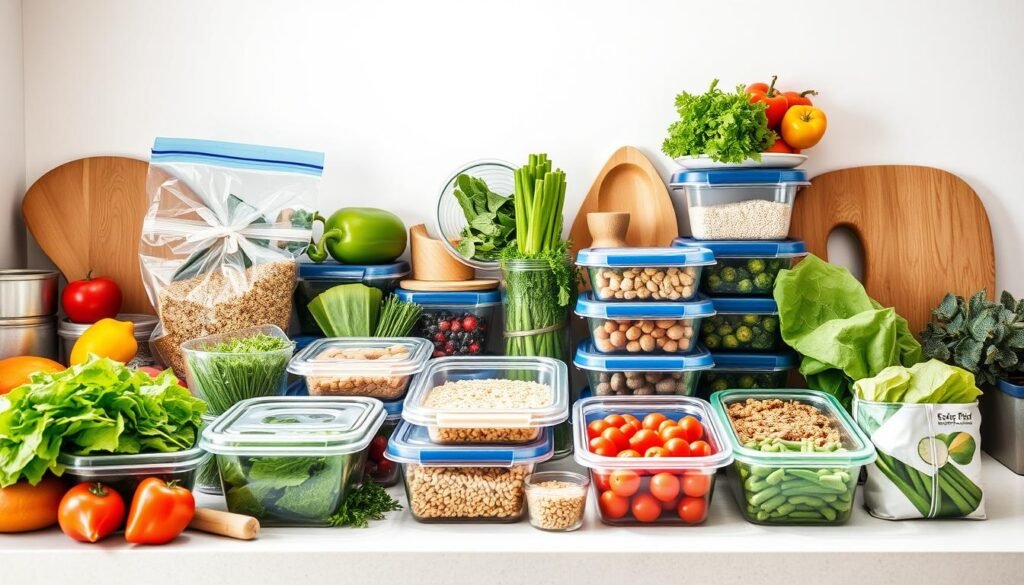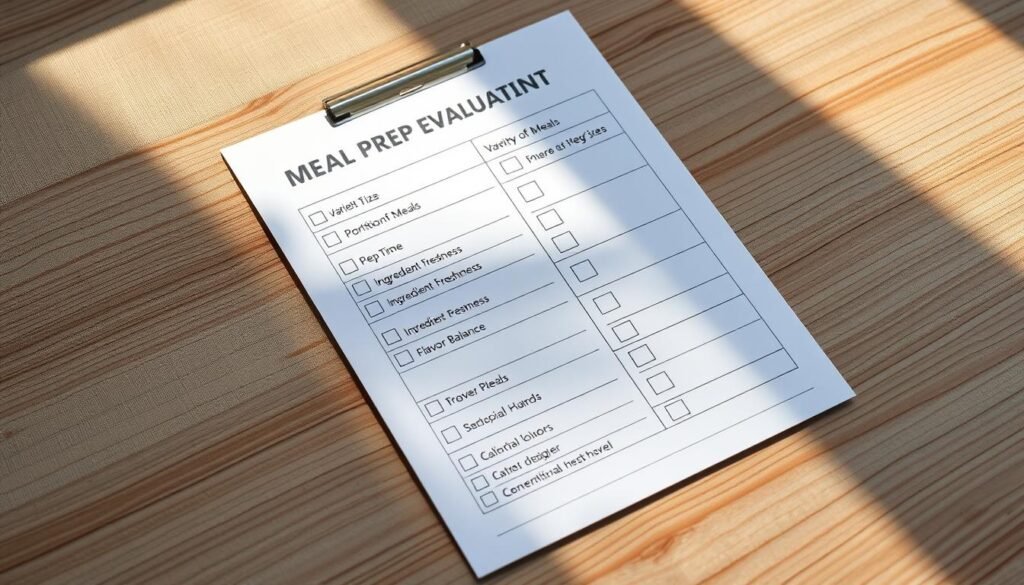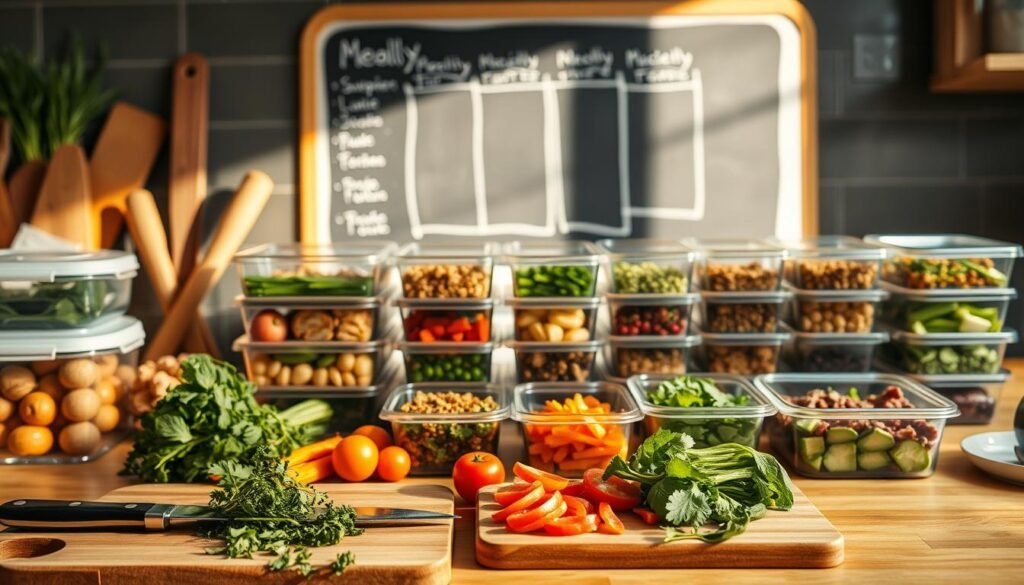Work, family, and personal life can leave little time for cooking. That’s why smart strategies are key. By spending a few hours each week on planning and preparing meals, you’ll avoid last-minute takeout and wasted food. Imagine having ready-to-eat dishes in your fridge that fit your schedule and taste.
This guide offers practical tips for busy lives. You’ll learn to cook proteins in bulk, use leftovers creatively, and organize ingredients for quick meals. These methods save time and make meals balanced, affordable, and stress-free.
Key Takeaways
- Save 3+ hours weekly with streamlined cooking routines
- Reduce food waste by up to 40% through strategic ingredient use
- Maintain nutritional goals without sacrificing flavor
- Adapt recipes to accommodate dietary preferences
- Start your first prep session in under 30 minutes
These solutions are for everyone, whether you’re new to kitchen organization or looking to improve your routine. Tomorrow’s lunch could be as simple as reheating a pre-portioned container—no chopping or cleanup needed.
Why Meal Prep is Essential for Busy Lives
Imagine starting your week with a clear plan for your meals. No more frantic takeout orders or last-minute grocery trips. Meal prep is more than a trend; it’s a must-have for those juggling work, family, and personal goals. Let’s explore why it’s become a non-negotiable for busy Americans.
Benefits of Meal Prep
Meal planning helps you avoid the fast food trap that can harm your health goals. By prepping healthy meal prep recipes ahead, you’re 74% more likely to hit your daily nutrition targets, a Harvard study found. The benefits include:
- Controlling portions with nutrient-rich foods
- Less stress over what to eat
- Managing dietary needs better
Time-Saving Advantages
Invest 2 hours on Sunday to save 10+ hours during the week. Here’s how meal prep compares to daily cooking:
| Activity | Meal Prep | Daily Cooking |
|---|---|---|
| Weekly Grocery Trips | 1 | 3-4 |
| Daily Kitchen Time | 15 mins | 45 mins |
| Monthly Savings | 22 hours | 0 hours |
Cost-Effective Strategies
Budget-friendly meal prep begins with smart shopping. Buying in bulk, like rice, beans, and frozen veggies, can slash grocery bills by 30-40%. Here are some tips:
- Choose seasonal produce for savings
- Turn leftovers into new dishes
- Freeze extra food for later
By combining these strategies with healthy meal prep recipes, you create a system that saves money and mental energy. The average family throws away $1,500 a year on uneaten food. Meal prep prevents this by planning meals precisely.
Getting Started with Meal Prep
Starting with meal prep is easy with three key things: good containers, useful tools, and a flexible plan. These basics save time and cut down stress, no matter if you’re cooking for one or a whole family. Let’s look at each part to build your meal prep base.
Choosing the Right Containers
Leak-proof glass containers like Pyrex are great for soups, sauces, and marinated meats. They’re safe for microwaves, good for the planet, and don’t hold smells. For controlling portions, choose BPA-free plastic containers with sections. They’re perfect for keeping grains, veggies, and proteins separate.
| Type | Best For | Durability | Price Range |
|---|---|---|---|
| Glass | Reheating meals | 10+ years | $15-$40/set |
| BPA-free Plastic | Portioning snacks | 3-5 years | $8-$25/set |
| Stainless Steel | Freezer storage | Lifetime | $20-$60/set |
Essential Prep Tools
Stock your kitchen with these time-saving tools:
- Sharp chef’s knife (6-8″ blade)
- Collapsible silicone measuring cups
- Adjustable vegetable chopper
A good food processor makes slicing and dicing quicker. For simple meal prep, an Instant Pot is handy. It cooks grains and proteins at the same time.
Creating a Weekly Plan
Follow these 4 steps:
- List 3-4 main proteins (chicken, tofu, beans)
- Choose 2 cooking methods (roast, sauté, slow-cook)
- Batch-prep staples (rice, chopped veggies)
- Use a whiteboard or app to track meals
Digital templates like Google Sheets help you reuse plans. For those who like visuals, color-code ingredients on your shopping list.
Easy Meal Prep Recipes for Breakfast
Start your day without stress with these quick, make-ahead breakfast ideas. They fuel your day and are easy to grab on the go. Perfect for busy mornings, they’re ready in minutes.

Overnight Oats Ideas
Overnight oats are the perfect make-ahead meal for busy mornings. Just layer oats, milk, and your favorite toppings in a jar. Let it soak overnight for a creamy breakfast ready to eat.
Try these combos:
- Peanut butter banana with chia seeds
- Blueberry almond with a drizzle of honey
- Pumpkin spice with crushed pecans
Egg Muffins for Quick Mornings
Make protein-packed egg muffins with leftover veggies or cooked meats. Pour eggs into a muffin tin, add mix-ins, and bake at 350°F for 20 minutes. They freeze well – just microwave for 60 seconds.
Great with whole-grain toast or fresh fruit.
Smoothie Packs for Easy Blending
Freeze fruit, spinach, and add-ins like protein powder in ziplock bags. When ready, blend with liquid (milk, juice, or water). For more breakfast meal prep ideas, try these:
- Tropical: mango, pineapple, coconut milk
- Green powerhouse: kale, banana, almond butter
- Berry blast: mixed berries, Greek yogurt, oats
Lunch Meal Prep Ideas That Save Time
Prepping lunches ahead of time makes your midday meals easy and tasty. You can make lunches that stay fresh for up to four days. Here are three quick meal prep methods to make your life easier.
Quinoa Salad Variations
Quinoa salads are full of protein and can be changed up in many ways. Start with cooked quinoa, then add veggies, herbs, and dressings. You can make five different salads from just one batch.
| Base Recipe | Add-Ins | Dressing | Protein |
|---|---|---|---|
| 3 cups cooked quinoa | Cherry tomatoes, cucumber, feta | Lemon-tahini | Grilled chicken |
| 3 cups cooked quinoa | Roasted sweet potato, kale | Balsamic vinaigrette | Chickpeas |
| 3 cups cooked quinoa | Black beans, corn, avocado | Cilantro-lime | Shredded pork |
Wraps and Sandwiches
Prep wraps in advance for quick lunches. Use whole-grain tortillas or flatbreads. Layer ingredients in this order to avoid sogginess:
- Spread hummus or avocado first
- Add crunchy veggies (bell peppers, carrots)
- Top with protein (turkey, tofu, or lentils)
Wrap tightly in parchment paper and store in reusable containers. Keep dressings separate until you’re ready to eat.
Grain Bowls You Can Customize
Grain bowls are great for using leftovers. Use this layering technique for maximum freshness:
- Base: Brown rice, farro, or couscous
- Veggies: Roasted or raw (broccoli, spinach)
- Protein: Grilled shrimp, baked tofu, or hard-boiled eggs
- Sauce: Peanut drizzle or Greek yogurt ranch
For more ideas, check out these healthy meal prep ideas. Try Mediterranean, Asian, or Mexican flavors to keep things interesting!
Dinner Solutions for Weeknight Meals
Weeknight dinners don’t have to be stressful. With a little planning, you can make tasty meals that fit your busy schedule. Let’s look at three ways to make evenings easier: one-pan dishes, slow cooker meals, and pasta dishes perfect for leftovers.
One-Pan Dinners
Sheet-pan meals are perfect when you’re short on time. Mix chicken, bell peppers, and onions with fajita spices. Roast it all in 25 minutes for tender chicken and caramelized veggies.
Try these combos:
- Salmon + asparagus + lemon slices
- Sausage + sweet potatoes + Brussels sprouts
Prep ingredients ahead and store them in ziplock bags. This makes assembly quick and reduces cleanup by 70% compared to cooking with multiple pots.
Slow Cooker Favorites
Your crockpot makes make-ahead meal kits easy. Prepare freezer bags with:
- Beef stew ingredients (chuck roast, carrots, potatoes)
- Vegetarian chili (beans, tomatoes, spices)
- Shredded chicken (breasts, broth, garlic)
Thaw kits overnight, then cook them in the slow cooker in the morning. Come home to a ready-to-eat meal that just needs a salad or bread.
Batch-Cooked Pasta Dishes
Cook once, eat twice (or three times!) with freezer-friendly pasta. Lasagna rollups are great – fill tortillas with ricotta and spinach, layer with sauce, and freeze in portions.
Other favorites include:
- Baked ziti with sausage and marinara
- Chicken Alfredo penne in individual containers
Most baked pasta dishes can be frozen for 3 months. Reheat at 375°F for 35-40 minutes straight from the freezer.
Snack Prep: Healthy Options to Grab On-the-Go
Busy days need snacks that keep you going without a hitch. Smart prep lets you make healthy bites that curb hunger and save time. Here are three easy ways to fill your fridge and pantry with quick snacks.

Energy Bites for a Quick Boost
Energy bites are quick to make and last all week. Just blend dates, oats, almond butter, and chia seeds. Roll them into balls and chill. Add dark chocolate chips or coconut flakes for a twist. These bites are full of fiber, protein, and healthy fats to beat mid-day hunger.
Veggie Packs with Dip
Keep celery, bell peppers, and cucumbers fresh in airtight containers. Match them with Greek yogurt dip flavored with dill or garlic. This mix offers crunch and protein without too many calories. For more ideas, see this ultimate guide to healthy snacking.
Homemade Trail Mix Ideas
Avoid sugary store mixes. Mix your own with raw nuts, unsweetened dried fruit, and seeds. Try almonds, pumpkin seeds, and dried cherries for a tasty mix. Store them in small bags to avoid overeating.
| Snack Type | Prep Time | Key Ingredients | Storage Tips |
|---|---|---|---|
| Energy Bites | 15 mins | Dates, oats, nut butter | Fridge (7 days) |
| Veggie Packs | 10 mins | Fresh veggies, Greek yogurt | Fridge (4 days) |
| Trail Mix | 5 mins | Nuts, seeds, dried fruit | Pantry (2 weeks) |
These easy meal prep ideas make snack time a chance to fuel your body. Prep parts like chopped veggies or trail mix bases to make assembly easy. With a bit of planning, you’ll always have healthy meal prep recipes ready.
Tips for Storing and Freezing Meals
Your make-ahead meals need proper storage to stay fresh and safe. Whether you’re new to simple meal prep or experienced, these tips will help. They ensure your efforts are rewarded all week.
Best Practices for Storing Meals
Choose the right containers for your food. Glass for acidic dishes, BPA-free plastic for the freezer. Cool foods quickly before sealing.
For layered meals like salads, keep dressings separate. This keeps the texture right.
- Cool foods completely before sealing containers
- Leave ½ inch space in freezer containers for expansion
- Use moisture-proof wraps for freezer-bound proteins
How Long Can You Freeze Food?
Freezing stops bacteria but changes texture over time. Here’s a guide for the best quality:
| Food Type | Refrigerator (Days) | Freezer (Months) |
|---|---|---|
| Cooked Chicken | 3-4 | 4-6 |
| Vegetable Soup | 4-5 | 2-3 |
| Pasta Dishes | 3-5 | 1-2 |
Labeling and Organizing Your Meal Prep
Use a freezer inventory template. Try a color-coded system:
- Red labels for high-protein meals
- Green labels for plant-based dishes
- Blue labels for kid-friendly options
Include prep dates and reheating tips. Store newer items behind older ones. This keeps things fresh!
Incorporating Variety into Your Meal Prep
Eating the same meals every week can get boring fast. The key to keeping your meal prep exciting is strategic variety. This means using different flavors, seasonal ingredients, and creative themes. It keeps your meals interesting without adding extra work.
Spice and Sauce Variation Ideas
Turn simple ingredients into new dishes with just a few sauce changes. Start with a base like Greek yogurt or tahini. Then, mix in different flavors to create five unique tastes:
- Zesty Lemon-Dill: Add fresh dill, lemon zest, and garlic
- Smoky Chipotle: Blend with adobo sauce and lime juice
- Asian-Inspired: Mix in ginger, soy sauce, and sesame oil
Keep sauces in small bottles for easy use. “A good spice rack is a meal prep game-changer,” says chef Maria Gonzalez. “Just changing one seasoning can make leftovers new again.”
Seasonal Ingredients to Utilize
Use nature’s schedule to add variety to your healthy meal prep recipes:
- Spring: Asparagus, peas, strawberries
- Summer: Zucchini, corn, peaches
- Fall: Butternut squash, apples, kale
Seasonal produce is often cheaper and tastes better. Try roasting winter veggies with rosemary one week. Then, grill summer veggies with basil pesto the next.
Rotating Recipes for Freshness
Try a three-week rotation to avoid getting tired of the same meals. Here are some meal planning tips:
| Week 1 | Week 2 | Week 3 |
|---|---|---|
| Mediterranean Bowls | Asian Stir-Fry | Mexican Fajitas |
| Lemon-Herb Chicken | Teriyaki Salmon | Spiced Black Beans |
Plan theme nights like Taco Tuesday or Stir-Fry Friday. Also, switch up your proteins. Try chicken thighs one week, tempeh the next, and shrimp after that.
Making Meal Prep a Family Affair
Turning meal prep into a group activity doesn’t just save time—it creates opportunities for connection. Whether you’re new to meal prep for beginners or refining your routine, getting everyone involved builds teamwork and teaches lifelong skills. Start with small, manageable tasks to keep the energy positive and avoid overwhelm.
Involving Kids in the Process
Kids love hands-on activities, and meal prep is no exception. Assign age-appropriate jobs like washing veggies, stirring mixes, or assembling snack packs. For younger children, use plastic knives to practice cutting soft foods like bananas or cooked carrots. Older kids can measure ingredients or read recipe steps aloud. This builds confidence while sneaking in math and reading practice.
Assigning Meal Prep Roles
Create a system where everyone has a specific responsibility. Try these roles for simple meal prep success:
- Ingredient Organizer: Gathers all items needed for recipes
- Spice Mixer: Combines seasonings in small containers
- Quality Checker: Ensures containers are sealed properly
Rotate roles weekly to maintain excitement and develop diverse skills.
Making It Fun and Educational
Turn prep time into a game with these ideas:
- Host a “colorful plate” challenge using rainbow veggies
- Create DIY labels with fun food facts
- Set timers for friendly “speed prep” competitions
Pair these activities with nutrition discussions—explain why proteins help muscles grow or how fiber keeps energy steady. Download our free Kid-Friendly Kitchen Skills Guide to make learning tangible.
The Best Apps for Meal Planning
Make meal planning easier with tech tools. These apps help organize recipes, create grocery lists, and fit your diet. They turn chaotic weeks into easy meal times.
Top Meal Prep Apps to Consider
Three apps are great for ease and function:
- Paprika: It syncs recipes and adjusts serving sizes. It also tracks your pantry to reduce waste.
- Mealime: It uses AI to suggest recipes based on your time and health goals. It’s perfect for quick meal prep beginners.
- Plan to Eat: It lets you plan meals on a calendar. It also sorts shopping lists by aisle to save time.
| App | Best For | Unique Feature | Price |
|---|---|---|---|
| Paprika | Recipe collectors | Pantry inventory | $4.99/month |
| Mealime | Diet customization | AI meal suggestions | Free (Pro: $5.99/month) |
| Plan to Eat | Family planners | Aisle-sorted lists | $4.95/month |
Features to Look for in an App
Focus on these to get the most out of an app:
- Cross-platform sync: Access your plan on phones, tablets, or laptops
- Recipe scaling: Adjust portions without recalculating ingredients
- Nutrition tracking: Monitor macros or allergens effortlessly
Apps with features for sharing plans are great. They let everyone add requests or mark tasks done. Look for apps with batch cooking plans for quick meal prep fans.
How Tech Can Streamline Your Process
Automation saves a lot of time. Mealime’s algorithm, for example, makes shopping lists and considers leftovers. One user said:
“I saved 3 hours weekly by using the app. Its 30-minute meal filters changed our dinners.”
Connect apps with smart kitchen gadgets for more convenience. Instant pot or slow cooker integrations adjust cooking times. Set reminders for defrosting or chopping.
Adjusting Meal Prep for Dietary Needs
Meal prep works for any diet. You can swap ingredients and plan well to save time and meet your dietary goals. Let’s explore how to adjust your meal prep for three common needs.
Meal Prep for Vegans and Vegetarians
Plant-based diets offer endless variety. Swap animal proteins with lentils, chickpeas, or tofu in your healthy meal prep recipes. Make vegan Buddha bowls with quinoa, roasted veggies, and tahini dressing for lunches.
For beginners, try prepping chia pudding or black bean tacos. They’re simple and keep well.
Use these staples to simplify your routine:
- Pre-cut veggies for stir-fries or salads
- Cooked grains like farro or brown rice
- Homemade hummus for protein-packed snacks
Gluten-Free Meal Prep Ideas
Gluten-free prep requires separate containers and utensils. Cauliflower rice bowls with grilled chicken or shrimp are easy freezer meals. Make gluten-free overnight oats with certified oats and almond milk for breakfasts.
| Ingredient | Gluten-Free Swap | Prep Tip |
|---|---|---|
| Pasta | Quinoa or chickpea pasta | Cook 2-3 servings for weekly use |
| Breadcrumbs | Crushed nuts or seeds | Store in airtight jars |
| Soy Sauce | Tamari or coconut aminos | Buy in bulk for cost savings |
Low-Carb Options Made Easy
Choose high-protein ingredients and veggie-heavy dishes. Spiralized zucchini noodles with turkey meatballs or egg muffin cups with spinach are great for meal prep for beginners. Keep nuts or cheese cubes for quick snacks.
Try these strategies to stay on track:
- Roast two sheet pans of low-carb veggies (broccoli, peppers, asparagus)
- Hard-boil a dozen eggs for grab-and-go protein
- Prep individual guacamole servings in small containers
Budget-Friendly Meal Prep Tips
Want to save money on meal prep? These tips can cut your grocery bills by up to 30% without losing flavor or nutrition. With smart planning and creative use of ingredients, you’ll get great budget-friendly meal prep. Your wallet and stomach will thank you all week.

Shopping on a Budget
Begin with meals centered on affordable items like beans, rice, and frozen veggies. Look at prices by unit (e.g., cost per ounce) and choose store brands over name brands. They’re often just as good. Here’s a table to help you find savings:
| Item | Bulk Price | Individual Price | Savings |
|---|---|---|---|
| Brown Rice | $0.18/oz | $0.33/oz | 45% |
| Chicken Breast | $2.99/lb | $3.79/lb | 21% |
| Frozen Broccoli | $1.25/10 oz | $1.75/10 oz | 29% |
Utilizing Grocery Sales
Look at weekly flyers before planning meals. Use sales to your advantage, like making tacos, chili, and lettuce wraps with ground turkey. Apps like Flipp or Grocery Pal can track deals. Pro tip: Buy non-perishables during holiday sales for big savings (like pasta for $0.99 per box).
Making the Most of Leftovers
Use last night’s veggies in omelets or soups. Grains like quinoa can be stir-fry bases or salad toppings. Try these ideas:
- Extra grilled chicken → Chicken Caesar wraps
- Steamed rice → Fried rice with scrambled eggs
- Roasted sweet potatoes → Breakfast hash with eggs
Keep track of savings with this formula: (Total meal cost ÷ servings) = Cost per meal. You’ll see how these meal planning tips really add up!
Overcoming Common Meal Prep Challenges
Meal prep can hit unexpected snags, but you don’t have to give up. Whether it’s work deadlines or family duties, three strategies can help. Let’s face the most common obstacles together.
Dealing with Time Constraints
Short on hours? Try the 90-minute weekly prep system. Spend one block of time cooking staples like grilled chicken, roasted veggies, and quinoa. Here’s a simple plan:
- 30 minutes: Chop vegetables and marinate proteins
- 45 minutes: Cook grains and roast sheet-pan meals
- 15 minutes: Portion meals into containers
Use quick recipes like stir-fries or salads that cook fast. Keep freezer-friendly meals for busy days.
Managing Ingredient Prepping
Make an ingredient hierarchy to make prep easier. Start with items that take the longest to cook or spoil fastest:
- Proteins (chicken, tofu, beans)
- Whole grains (rice, farro, pasta)
- Fresh vegetables (broccoli, bell peppers, leafy greens)
Pre-portion spices and sauces in small containers. This keeps flavors exciting and reduces prep time.
Staying Motivated to Meal Prep
Beat boredom with themed prep days like “Meatless Monday” or “Taco Tuesday.” Use a checklist or app to track your progress. Celebrate milestones – like trying a new gadget after four weeks.
Beginners, start with 2-3 days of meals. Small victories build confidence and make the habit easier to keep.
Staying Inspired with New Recipes
Finding new healthy meal prep recipes is easy today. With digital tools and global flavors, you can try anything. From Mediterranean bowls to protein wraps, there’s endless inspiration. Here are three ways to keep your meal prep fresh and fun.
Following Food Blogs and Influencers
Check out Budget Bytes and Fit Foodie Finds for affordable, easy recipes. Social media is full of easy meal prep ideas for those on the go. Try quick stir-fries or burritos that freeze well.
For the latest trends, adapt TikTok hits like “cloud bread” or sheet-pan fajitas. Prep ingredients in advance to make it easier.
Joining Meal Prep Communities
Reddit’s r/MealPrepSunday and Facebook’s Meal Prep Warriors are great for recipe ideas and tips. People share their meal prep photos, inspiring you to try new things. Join challenges like “Meatless Monday Prep” to challenge yourself without stress.
Experimenting with New Cuisines
Try global spice kits from McCormick to explore new flavors. Add Moroccan harissa to roasted veggies or Japanese furikake to rice dishes. Many stores now sell pre-chopped international veggies for quick meals.
Evaluating Your Meal Prep Success
Tracking your progress is key to making meal prep work long-term. Use our 4-step evaluation system to measure time savings, grocery costs, nutritional balance, and personal satisfaction. This approach helps you spot patterns and refine your strategy without guesswork.

Assessing What Works
Start by reviewing your last month’s meals. Ask yourself:
- Which recipes took less than 30 minutes to reheat?
- Did you avoid last-minute takeout orders?
- How much did you spend compared to eating out?
Create a simple table to compare results:
| Metric | Week 1 | Week 2 |
|---|---|---|
| Time Saved | 3.5 hours | 4 hours |
| Cost Per Meal | $4.20 | $3.80 |
Adjusting Based on Feedback
Gather input from family members or roommates. If “the chicken dishes got repetitive” or “veggie portions were too small,” tweak your next plan. For budget-friendly meal prep, swap expensive proteins with lentils or eggs when costs spike.
“Successful meal preppers aren’t rigid – they’re responsive to their needs and pantry surprises.”
Setting New Goals for Your Meal Prep
Build on your wins with SMART targets:
- Add one new cuisine style monthly (try Thai or Mediterranean)
- Reduce food waste by 25% through better portioning
- Master freezer-friendly breakfasts for hectic mornings
Revisit these meal planning tips every 6-8 weeks. Celebrate when you hit targets, then raise the bar slightly. This cycle turns meal prep from a chore into a sustainable superpower.
Conclusion: Transform Your Weeks with Meal Prep
Meal prep makes chaotic weeks easier to manage. By spending a few hours planning, you control your nutrition, save money, and lower stress. These easy meal prep ideas fit any schedule or diet.
Revisiting the Benefits
Seeing results makes sticking to a routine easier. Preparing meals ahead of time reduces takeout and ensures healthy choices. You’ll also save on grocery trips and try new recipes.
Using tools like glass containers or a slow cooker keeps things efficient. This helps you stay on track.
Building Your Routine
Begin with a 30-day plan. Use a printable calendar to track your progress and note your favorite dishes. Apps like Paprika or Plan to Eat help organize recipes. Seasonal ingredient lists keep your meals exciting.
Share your meal prep journey online. Post your dishes on Instagram with #MealPrepMagic. This way, you inspire others and make your weeks less stressful.
FAQ
How can meal prep save me money on groceries?
Meal prep helps by planning meals around sales and buying in bulk. This reduces waste and avoids impulse buys. Cooking proteins like chicken or lentils in bulk and using leftovers in new dishes saves money.
What are the best containers for leak-proof meal prep?
Glass containers like Pyrex’s 3-cup rectangles with locking lids are great for preventing spills. For snacks, Sistema’s divided containers are perfect for nuts, dips, and veggies.
Can I meal prep if I’m vegan or gluten-free?
Yes! Start with base ingredients like quinoa and roasted chickpeas. Use separate areas for prep to avoid contamination. Apps like Mealime offer recipes for different diets.
How long do prepped meals stay fresh in the fridge?
Cooked proteins last 3-4 days, while veggies and grains stay fresh up to 5 days. Use color-coded labels to keep track of what to use first and what to freeze.
What’s the fastest way to prep breakfasts for the week?
Overnight oats in Mason jars are quick. You can also freeze smoothie packs. For savory, egg muffins with spinach and feta reheat fast.
How do I prevent meal prep burnout with limited recipes?
Try theme weeks and master sauces like chimichurri. Swap ingredients like farro for rice or cumin for paprika to keep things interesting.
What kitchen tools are essential for beginner meal prep?
You need a good chef’s knife, sheet pans, and a 6-quart Instant Pot. A vegetable chopper saves time on prep work.
Can I freeze pre-assembled slow cooker meals?
Yes! Layer ingredients in freezer bags. Thaw overnight before cooking. It’s perfect for chili or curries.
How do I get kids involved in meal prep safely?
Use tools like Curious Chef nylon knives for soft veggies. Assign tasks based on age. Make it fun with nutrition flashcards.
What’s the best app for tracking meal prep nutrition?
Lose It! and MyFitnessPal are great for tracking. Macrostax helps with portion control and syncs with Apple Health.
How can I adapt meal prep for a low-carb diet?
Use cauliflower rice and lettuce wraps. Prep proteins like lemon-herb salmon with roasted Brussels sprouts. Snack on boiled eggs or celery with almond butter.
What’s the minimum time needed for weekly meal prep?
Our 90-minute Sunday prep works. Spend 30 mins chopping, 40 mins cooking, and 20 mins assembling. Use timers and cook multiple things at once.

